You have had a Weber Gas Grill since last month or a couple of months. It seems the minimum temperature it holds is really high with all three burners on low. Sometimes the temperature crosses the max (550 F) setting.

So, you can’t cook the chicken or fish evenly. Consequently, you go nuts and ask yourself- why is my weber gas grill too hot on a low setting?
Well, your Weber natural gas grill will run hotter if all the burners are on high or your grill getting a high-pressure burner. Besides, a defective gas regulator or faulty thermometer is also responsible for the temperature issue.
Besides installing the wrong type of orifice, a clogged burner and high outdoor temperature can cause a high heat issue.
Relax! Below, we will break down how to solve these issues to let you gain the ambient cooking temperature. So, let’s get started right here.
Table of Contents
- Weber Gas Grill Too Hot On Low Settings [Reasons + Solutions]
- 1. Gas Grill Regulator Problems
- 2. All The Burners May Be Set To High
- 3. You May Install a High-Pressure Burner
- 4. Dirty Grill
- 5. Mistakenly Install A Gas Orifice For Propane Grill
- 6. Air Shutter & Venturi Tube Problem
- 7. Outdoor Temperature Is Too Hot
- 8. Hose Connection Problem
- 9. The Thermometer May Give Inaccurate Results
- How Hot Should My Weber Grill Get?
- Tips To Avoid Too High Temperature On Gas Grill To Keep Food Unburned
- FAQ:
- What color should gas grill flame be?
- How do I know if my grill regulator is bad?
- Should I cook steaks low and slow?
- How often should I clean my Weber grill?
- Conclusion
Weber Gas Grill Too Hot On Low Settings [Reasons + Solutions]
The following culprits are responsible for your Weber gas grill running hotter.
1. Gas Grill Regulator Problems
A gas regulator on a grill regulates the flow of gas from your gas tank to the heating mechanism of your gas grill.
Generally, it’s a safety device, which adjusts the gas pressure. If it gets defective, you can’t control the gas flow. In other words, you will have no control over the heat when you will grill food.
For example, if you install the wrong type of gas regulator (especially a high-pressure one), it will flow more gas to your grill burners. As a result, you will get more heat or the grill will run hotter even on a low setting.
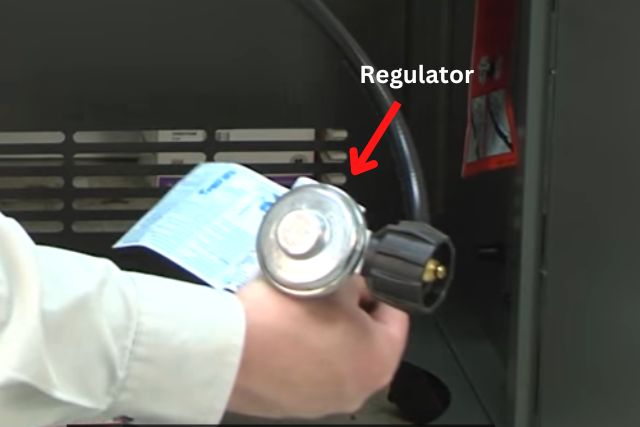
Similarly, Thus, the incorrect installation of the gas regulator can also cause your grill to run hotter.
In some cases, you may mistakenly install a propane regulator on your gas grill. In return, it will shoot up the flame and temperature of your gas grill at a low setting.
Keep in mind; both propane regulators and gas regulators are not the same and they are not interchangeable. Indeed, a propane regulator will never control the gas flow to your gas grill optimally as it produces more heat than a gas regulator.
Lastly, a damaged gas regulator can also be the reason behind this grill issue. If you don’t maintain the regulator regularly, dirt & debris will nest on it and block the regulator.
Due to the clogged gas regulator, you will get uncontrolled gas flow which will lead to dangerous situations.
Solution:
To solve this issue, ensure you install the right type of gas regulator on your grill. If the heat output of your grill is below 60000 BTUs, a basic gas regulator will be sufficient.
However, it’s better to check & read the BTU rating of the regulator before purchasing one.
On the other hand, you should get a single or two-stage regulator if the gas grill is over 60000 BTUs.
Once you choose the right type of gas regulator, it’s time to install it professionally. If you have a natural gas grill, install the regulator in the gas line of your house and tie the gas grill downstream of the gas regulator.
And in the case of your propane grill, to regulate the pressure the regulator is connected to the propane tank.
Next, make sure you pick a gas regulator for your gas grill. Never use a propane regulator for controlling the gas flow of your natural gas grill.
And finally, inspect the gas regulator for a clog by dirt & debris. If it gets dirty, clean it thoroughly to release the blockage. Otherwise, you should replace the gas regulator if it gets damaged.
2. All The Burners May Be Set To High
Weber Gas Grill running too hot! Probably, every burner of your grill is open and each of them is on a high. The Weber grill has three burners.
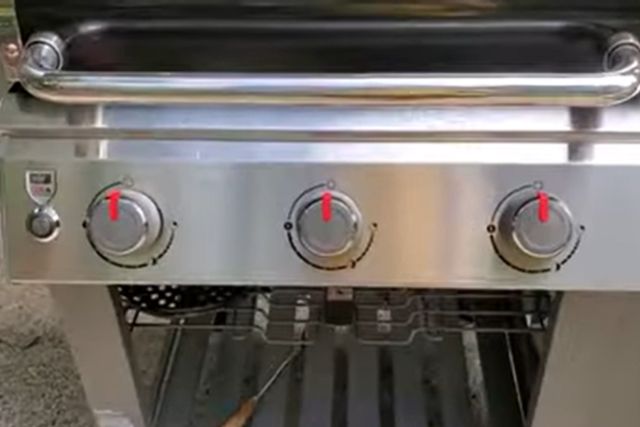
You can adjust them with knobs to control the cooking temperature. The gas grill knobs are shown below.
If you keep all the burners open and on a high setting, we bet the temperature of your grill will thrive. Yeah, high temperatures are great for searing. But it’s not good to cook chicken or fish.
Solution:
First off, check all the burners to see whether they are on high setting or not. If all of them are on high, adjust them to reduce the cooking temperature.
You can use the two ends and leave the middle burner off. If still, you can’t reduce the temperature, leave only one burner on and the other two off.
3. You May Install a High-Pressure Burner
It’s important to consider whether you install a high-pressure burner or a low which makes a big difference. A low-pressure burner will burn at lower temperatures.
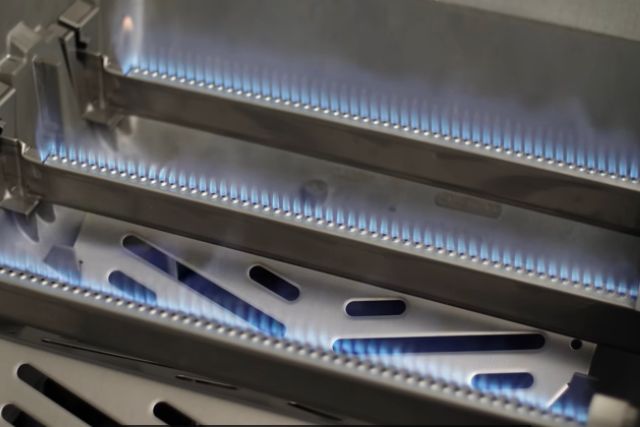
On the other hand, a high-pressure burner will burn at higher temperatures. This is the issue that may occur in your case. If you install a high-pressure burner, your gas grill will get too hot on low settings.
Solution:
The solution to this weber gas grill issue is pretty simple & straightforward. Just inspect whether you install the right gas burner or not.
If not, replace the high-pressure gas burner with a new low-pressure burner.
4. Dirty Grill
Dirty grill components can also cause your gas grill to trigger high temperatures. If the grill grate, cook pan, and heat deflector get heavily coated with burned grease, you will experience flare-ups or grease fires.
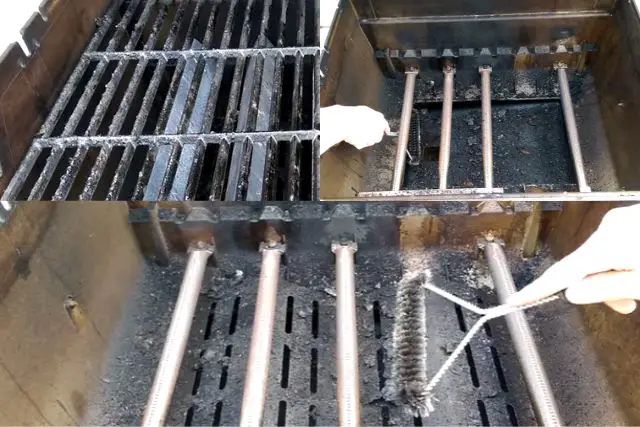
Consequently, the internal temperature of your gas grill will be too high. In addition, the clogged burners restrict the gas glow & you can see inconsistent flame out of the grill burners.
A huge flame will come out from some areas of the grill burner. On the other hand, there will be too small or no flames in some areas that is shown in the picture below.

Thus, your grill will distribute the flame unevenly if the holes of the burner are unmatched or they get clogged by debris & carbon buildup.
Solution:
Clean the internal parts like the grill grate and drip pan regularly so that grease can’t build up and clog the burner. If the burner gets clogged, release the blockage by cleaning it.
Also, don’t forget to clean the small holes or slots of the burner. You can use a small screwdriver or a brush to clean those slots.
You can check out this article from Weber to learn how to clean burner tubes.
5. Mistakenly Install A Gas Orifice For Propane Grill
You can find an orifice installed on the burner control valve. It works like a nozzle to maximize the velocity of the gas to let the gas mix with air in the venturi tube for combustion.
The orifice of a gas and propane grill is different. The natural gas orifice is double the size of a propane orifice just like the picture below.
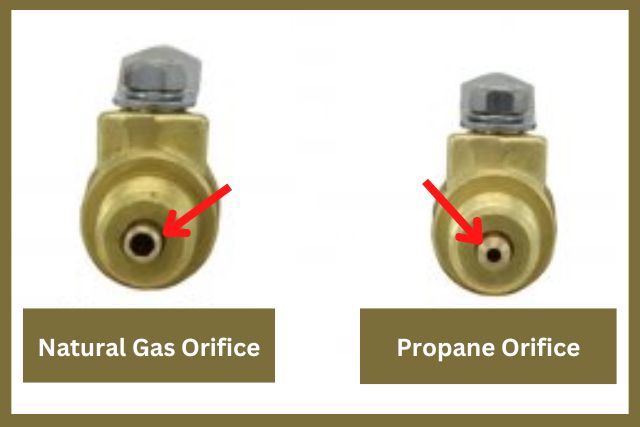
If you install the gas orifice for your propane grill, more gas will flow to the burner. Consequently, your propane grill will get too hot.
Solution:
Install the right size orifice on the burner control valve of your propane grill. To detect the proper size, take a 3/64” drill bit shank and try to insert it into the orifice. If you can’t insert it into the orifice, understand it’s a propane orifice.
Well, if you find the orifice size is correct, then don’t forget to inspect the orifice for carbon buildup. It can also cause your grill to run hotter even on a low setting.
If there is carbon buildup on the orifice, clean it with a damp cloth to fix the issue.
6. Air Shutter & Venturi Tube Problem
The air shutter is a grill part that allows a specific gas/air ratio that is required for standard combustion.
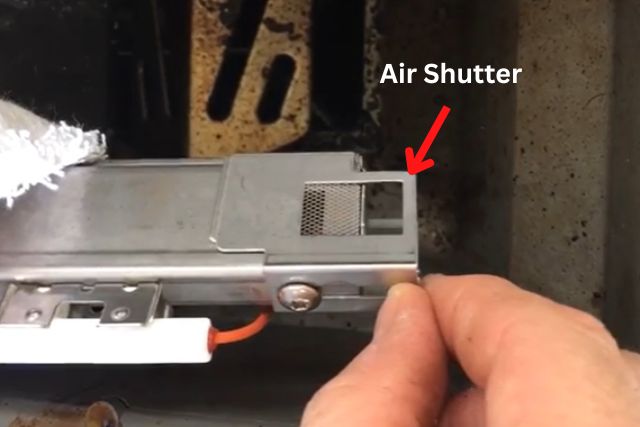
In case you incorrectly adjust the air shutter of your Weber gas grill, it also could be the culprit behind the grill overheating on a low setting issue.
Plus, if there are spider webs & insects nest in the grill’s venturi tube(s), the full gas flow is obstructed to flow to the burner & can cause a “flashback”.
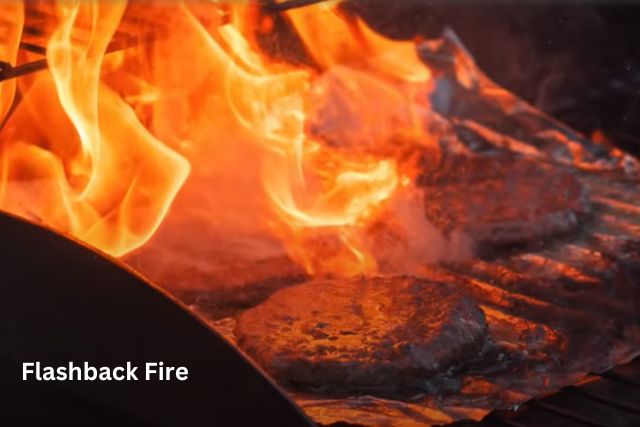
In fact, due to gas flow restrictions, some gas escapes at the venturi shutter. This backup gas may ignite in the venturi tube behind the control panel. It is called a “flashback fire” that can high the grill temperature & damage your grill, personal injury, or property.
Solution:
First, adjust the air shutter according to your grill manufacturer’s manual. You’ll get a screw on the shutter to adjust the opening so that a correct ratio of air & gas can mix.
Keep in mind, the air shutter opening for a natural gas grill is larger than a propane grill air shutter opening.
Here, watching this video will be helpful for you to adjust the air shutter of your Weber gas grill.
Next, visually inspect the venturi tubes & clean them thoroughly. Well, before checking & cleaning, be sure the grill is cold as you will need to remove the burner to do the task.
7. Outdoor Temperature Is Too Hot
If you operate your gas grill in the middle of the day or during the heat of Summer, you may find your grill to run hotter.
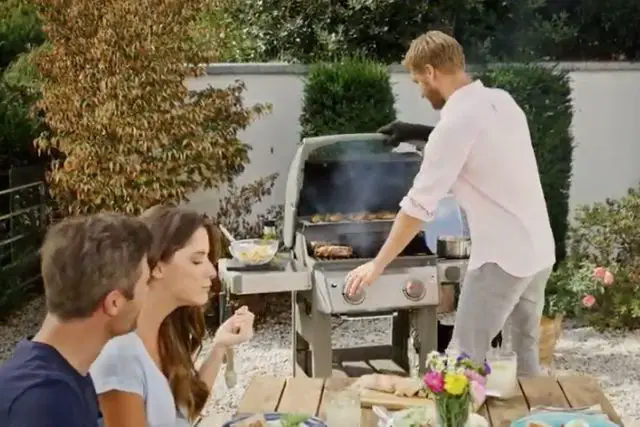
Higher temperatures outside may cause your grill to run a little hotter, even on low settings.
Solution:
This is not a grill problem at all. Just bring your gas grill under the shed. We recommend you to not operate your grill in the middle of the day during the summertime. We hope you don’t encounter this grill issue if you follow our suggestion.
However, you will get less cooking temperatures if the outdoor environment is too cold. In such a case, it will be helpful for you to read our ultimate solution guide on Weber gas grill not getting hot.
8. Hose Connection Problem
Incorrect hose connection installation also could be the culprit behind the grill being hotter on low settings while your grill pressure regulator installation is okay.
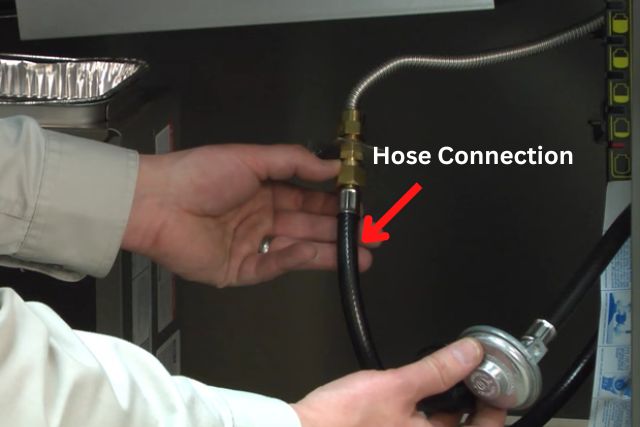
In fact, the natural gas hose has a higher diameter orifice that is to be used with natural gas. If you use this hose for your propane grill, it will allow more propane to flow & you’ll face the risen grill temperature issue.
Solution:
Install the correct hose connection for your weber gas grill according to the model. Plus, make sure there are no spider webs or dirt inside the hose that can disturb the gas flow.
One more thing, ensure the hose insulation of your grill is damage free. For example, when you grill on a sunny day in direct sunlight, a defective insulated hose fails to control pressure due to excessive heat.
As a result, it allows the grill temperature to increase unexpectedly.
9. The Thermometer May Give Inaccurate Results
We all know Weber Gas Grill is amazing. But every thermometer in the grill lid is wildly inaccurate.
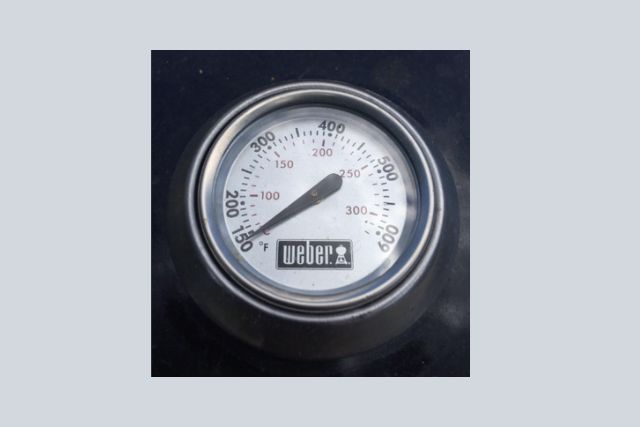
Perhaps, the temperature your Weber grill gives may be inaccurate. So, the only solution to measure the cooking temperature is to have a good thermometer.
Solution:
We recommend you get a good thermometer from a reliable brand to sense the cooking temperature of your grill. You can find a reliable grill thermometer on Weber. Also, you can consider other brands.
How Hot Should My Weber Grill Get?
All the Weber Gas Grills are designed to reach the maximum temperature between 500-550°F. Indeed, you will always get max cooking temp if you set it to a high position.

Many new Weber grill users may get confused if the temperature rises to 500-550° F. Below, we charted the standard temperature ranges for low, medium, and high by turning on all the burners.
| Temperature Ranges | Degree |
| Low & Slow | 200-250° F |
| Low | 250-350° F |
| Medium | 350-450° F |
| High | 450-550° F |
Gaining these temperatures is not rocket science. Just play with the heat settings and the number of control knobs to get these temperatures.
Tips To Avoid Too High Temperature On Gas Grill To Keep Food Unburned
01. Keep The Grill Always Clean
If you clean the grill after every cook, you will get ambient cooking temperature. On the other hand, you won’t get enough even heat, experience a grease fire, or have high heat on a low setting with your dirty grill.
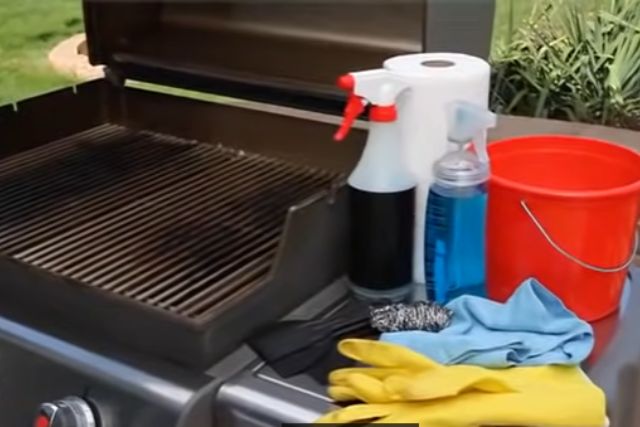
Well, you can watch the video on cleaning the Weber gas grill easily.
02. Cook With Indirect Heat
It’s a smart way to cook with indirect heat to prevent food from burning as if you convert your grill into an oven.
Well, in the indirect cooking method, generally, the burners are on one or both sides of the food & the central burner remains off.
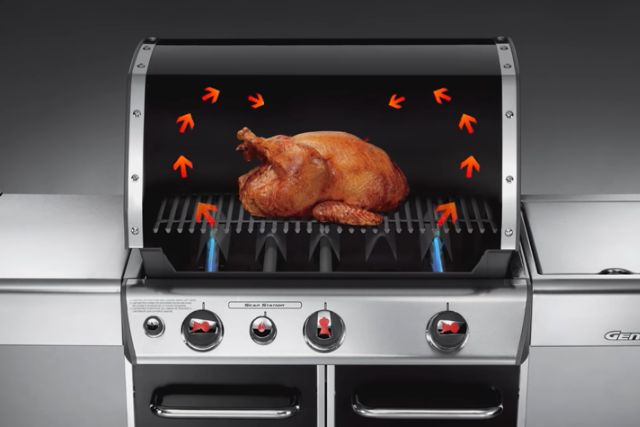
The food is placed on the center burner as you can see in the above picture. Keep in mind, you need to preheat the grill for 10 minutes before starting to cook.
03. Don’t Turn On The Sear Knob
The searing zone is an area that gets too hot faster than the rest of the grill grate. This area is designed to create perfect grill marks on the food within 2-3 minutes for each side.
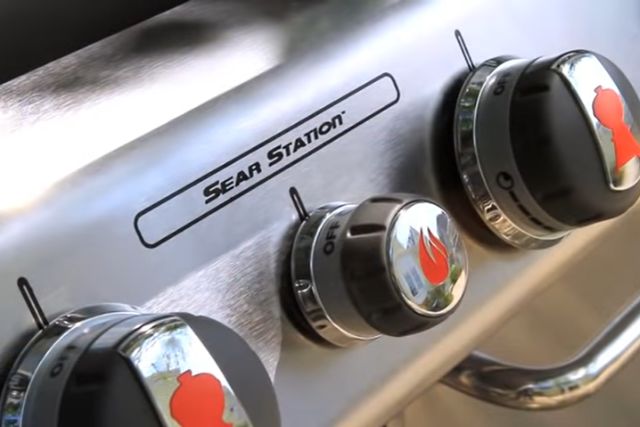
However, if your weber gas grill has a sear station knob(small than the other knobs) that is shown in the above picture, don’t turn it on unnecessarily.
04. Use A Heat Diffuser While Cooking
A heat diffuser is a heavyweight steel flat cooking surface that spreads heat evenly.
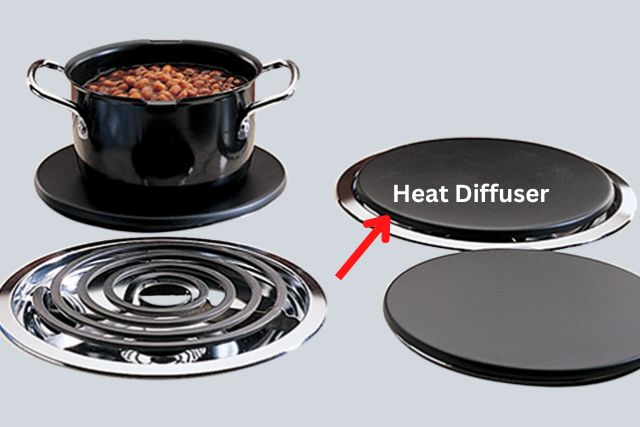
As a result, it can prevent your food from too hot temperature of your gas grill. So, you can place a heat diffuser on the grill grate that you can see below.
FAQ:
What color should gas grill flame be?
Your gas grill flame indicates that the air & gas mixing ratio is correct & it’s operating properly. Well, the flame should be light blue towards the top, darker blue towards the bottom. Also, you may sometimes find the tips of the flames flicker yellow that is normal. However, if you face the issue with yellow flame of your gas grill, you can check out this article to get rid of it.
How do I know if my grill regulator is bad?
Usually, the regulator of a gas grill becomes bad slowly over time. The following points indicate that you need to check & replace the regulator-
- The burners produce uneven flames
- Getting low heat from the burners even when the gas grill is turned on high
- Low flames
- Getting lower & lower temperature overtime
Should I cook steaks low and slow?
Yes, you can slowly cook the stakes on your grill’s low heating zone, then sear it at a high heat. As a result, you’ll get perfectly cooked steaks with beautiful grill marks & brown crust. Plus, you can serve it after cooking without any resting period due to your low heat cooking process.
How often should I clean my Weber grill?
It’s better to clean your Weber gas grill grates after every use. In this case, just preheat the grill for 10-15 minutes, then brush the grates with a stainless steel grill brush to clean. Well, when it comes to deep interior cleaning, we recommend every 3 months or so. Plus, you should clean the outer parts once a month.
Conclusion
After reading the article, now you know why your Weber gas grill is too hot on low setting and how to fix it by yourself.
So, whenever you face such a heating issue with your gas grill, inspect the factors we have explained and fix the reason.
If you won’t find the solution, then don’t hesitate to let us know your struggle in the comment box. We will come to you with possible solutions.

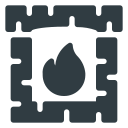
I have a GS4 spirit 2 weber gas grill and i cannot control the heat. I have replaced the regulator and tried turning the gas on very slowly and cleaning the grill from top to bottom. If i only turn two burners on low within 5 minutes i am at 500 degrees and climbing. I need help.
Hi Perry
Your weber grill gets too hot on a low setting due to one or more reasons like outdoor hot temperature, installation of a high-pressure burner, regulator problems, dirty grill, clogged burners, or you may install a gas orifice for a propane grill.
Well, as you have replaced the regulator & cleaned your grill, now visually inspect the other issues & try to fix them.
First, make sure, you cook outside but not in direct sunlight. Also, check whether you install the right gas burner or not. If not, replace the high-pressure gas burner with a new low-pressure burner.
Next, inspect the orifice as both are different. The natural gas orifice is double the size of a propane orifice. If you install the gas orifice for your propane grill, more gas will flow to the burner.
Consequently, your propane grill will get too hot. In this case, install the right size orifice on the burner control valve of your propane grill.
Hopefully, you will get the solution.
Best of luck!